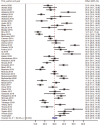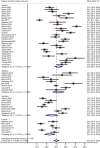Glycaemic control among type 2 diabetes patients in sub-Saharan Africa from 2012 to 2022: a systematic review and meta-analysis
- PMID: 36127712
- PMCID: PMC9487067
- DOI: 10.1186/s13098-022-00902-0
Glycaemic control among type 2 diabetes patients in sub-Saharan Africa from 2012 to 2022: a systematic review and meta-analysis
Abstract
Background: There is an increased burden of diabetes globally including in sub-Saharan Africa. The literature shows that glycaemic control among type 2 diabetes patients is poor in most countries in sub-Saharan Africa. Understanding the factors influencing glycaemic control in this region is therefore important to develop interventions to optimize glycaemic control. We carried out a systematic review to determine the prevalence and factors associated with glycaemic control in sub-Saharan Africa to inform the development of a glycaemic control framework in the Democratic Republic of the Congo.
Methods: We searched five databases (African Index Medicus, Africa-Wide Information, Global Health, PubMed, and Web of Science) using the following search terms: type-2 diabetes, glycaemic control, and sub-Saharan Africa. Only peer-reviewed articles from January 2012 to May 2022 were eligible for this review. Two reviewers, independently, selected articles, assessed their methodological quality using Joanna Briggs checklists, and extracted data. A meta-analysis was performed to estimate the prevalence of glycaemic control. Factors associated with glycaemic control were presented as a narrative synthesis due to heterogeneity as assessed by the I2.
Results: A total of 74 studies, involving 21,133 participants were included in the review. The pooled prevalence of good glycaemic control was 30% (95% CI:27.6-32.9). The glycaemic control prevalence ranged from 10-60%. Younger and older age, gender, lower income, absence of health insurance, low level of education, place of residence, family history of diabetes, longer duration of diabetes, pill burden, treatment regimen, side effects, use of statins or antihypertensives, alcohol consumption, smoking, presence of comorbidities/complications, and poor management were associated with poor glycaemic control. On the other hand, positive perceived family support, adequate coping strategies, high diabetes health literacy, dietary adherence, exercise practice, attendance to follow-up, and medication adherence were associated with good glycaemic control.
Conclusion: Suboptimal glycaemic control is pervasive among patients with type-2 diabetes in sub-Saharan Africa and poses a significant public health challenge. While urgent interventions are required to optimize glycaemic control in this region, these should consider sociodemographic, lifestyle, clinical, and treatment-related factors. This systematic review and meta-analysis protocol is registered in PROSPERO under CRD 42021237941.
Keywords: Factors; Glycaemic control; Meta-analysis; Prevalence; Sub-Saharan Africa; Systematic review; Type 2 diabetes.
© 2022. The Author(s).
Conflict of interest statement
The authors declare that they have no competing interests.
Figures
Similar articles
-
Poor glycaemic control: prevalence, factors and implications for the care of patients with type 2 diabetes in Kinshasa, Democratic Republic of the Congo: a cross-sectional study.Front Clin Diabetes Healthc. 2023 Nov 20;4:1241882. doi: 10.3389/fcdhc.2023.1241882. eCollection 2023. Front Clin Diabetes Healthc. 2023. PMID: 38076524 Free PMC article.
-
Elevated blood pressure among adolescents in sub-Saharan Africa: a systematic review and meta-analysis.Lancet Glob Health. 2023 Aug;11(8):e1238-e1248. doi: 10.1016/S2214-109X(23)00218-8. Lancet Glob Health. 2023. PMID: 37474231
-
Prevalence and factors associated with maternal and neonatal sepsis in sub-Saharan Africa: a systematic review and meta-analysis.Front Public Health. 2024 Jan 24;12:1272193. doi: 10.3389/fpubh.2024.1272193. eCollection 2024. Front Public Health. 2024. PMID: 38327574 Free PMC article.
-
Risk Factors and Prevalence of Dilated Cardiomyopathy in Sub-Saharan Africa: Protocol for a Systematic Review.JMIR Res Protoc. 2021 Jan 21;10(1):e18229. doi: 10.2196/18229. JMIR Res Protoc. 2021. PMID: 33475522 Free PMC article.
-
Gender-based violence among female youths in educational institutions of Sub-Saharan Africa: a systematic review and meta-analysis.Syst Rev. 2019 Feb 25;8(1):59. doi: 10.1186/s13643-019-0969-9. Syst Rev. 2019. PMID: 30803436 Free PMC article.
Cited by
-
Insulin therapy among diabetic patients in rural communities of Sub-Saharan Africa: a perspective review.Ther Adv Endocrinol Metab. 2024 Feb 19;15:20420188241232280. doi: 10.1177/20420188241232280. eCollection 2024. Ther Adv Endocrinol Metab. 2024. PMID: 38379780 Free PMC article. Review.
-
Poor glycaemic control: prevalence, factors and implications for the care of patients with type 2 diabetes in Kinshasa, Democratic Republic of the Congo: a cross-sectional study.Front Clin Diabetes Healthc. 2023 Nov 20;4:1241882. doi: 10.3389/fcdhc.2023.1241882. eCollection 2023. Front Clin Diabetes Healthc. 2023. PMID: 38076524 Free PMC article.
-
Poor glycemic control and associated factors among patients with type 2 diabetes mellitus: a cross-sectional study.Sci Rep. 2023 Jun 14;13(1):9673. doi: 10.1038/s41598-023-36675-3. Sci Rep. 2023. PMID: 37316565 Free PMC article.
-
Consensus on potential interventions for improving glycaemic control among patients with type 2 diabetes in Kinshasa, Democratic Republic of the Congo: a Delphi study.Glob Health Action. 2023 Dec 31;16(1):2247894. doi: 10.1080/16549716.2023.2247894. Glob Health Action. 2023. PMID: 37622241 Free PMC article.
-
The role of structural racism and geographical inequity in diabetes outcomes.Lancet. 2023 Jul 15;402(10397):235-249. doi: 10.1016/S0140-6736(23)00909-1. Epub 2023 Jun 22. Lancet. 2023. PMID: 37356447 Free PMC article. Review.
References
-
- World Health Organization . Global Report on Diabetes. Geneva: World Health Organization; 2016. pp. 6–86.
LinkOut - more resources
Full Text Sources




